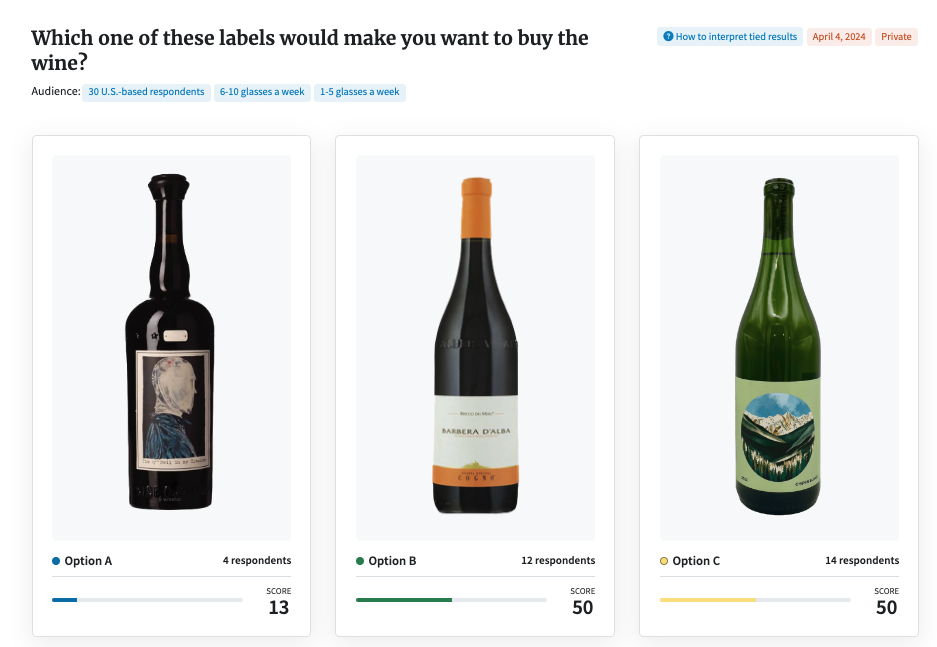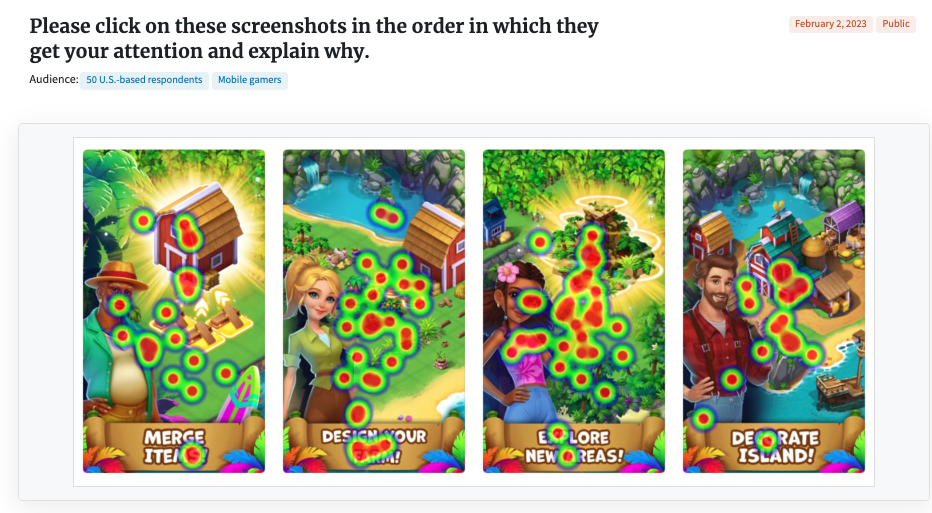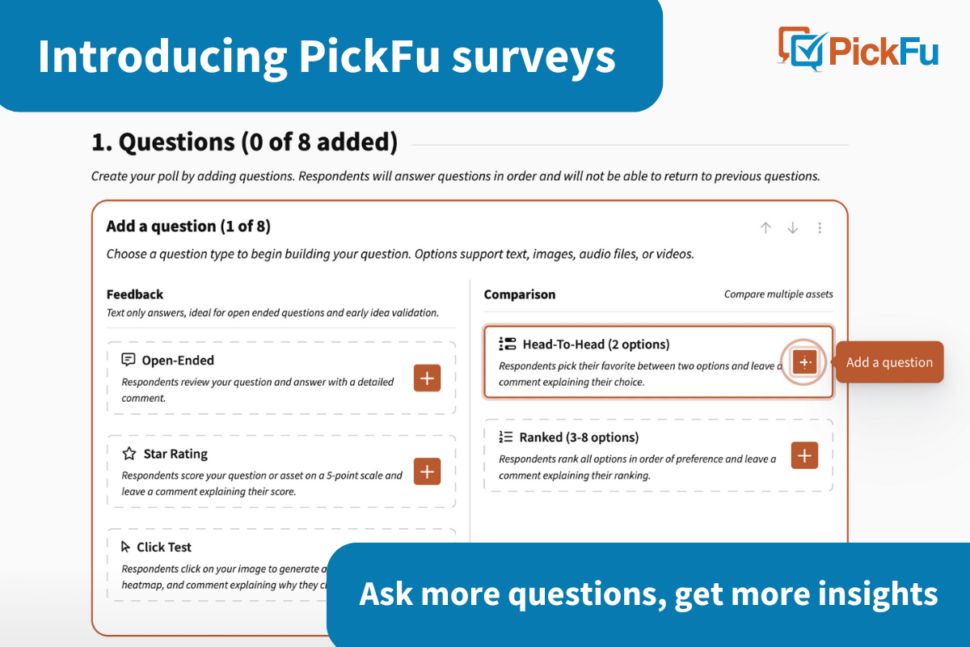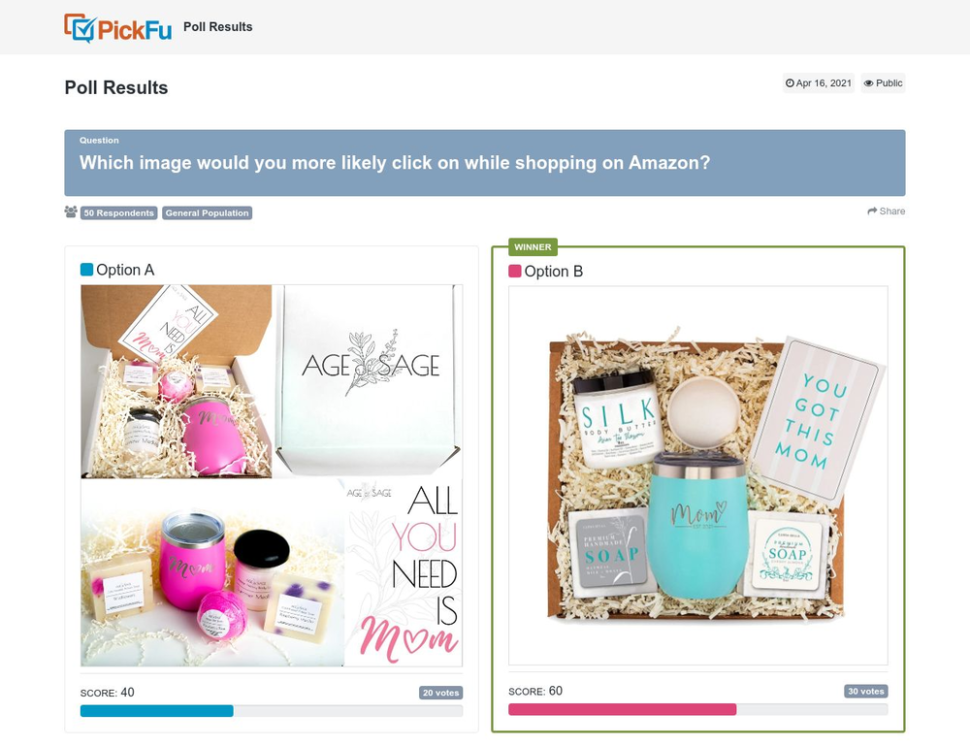Traditional market research – like running in-person focus groups or analyzing complicated consumer data – is often time-consuming and costly, causing delays that frustrate managers, designers, and marketers.
If you need fast insights to help you validate ideas, test products, or support decision-making without the long wait, you’ve come to the right place.
In this post, you’ll learn about rapid research methods and how they can enable you to improve product development, UX/UI feedback, marketing strategies, and more.
With 16 years of consumer research expertise, the team at PickFu can help you accelerate your research processes while maintaining high-quality data and insights. Learn how to set up a rapid research program to get valuable customer insights and keep your projects on track!
What is rapid research?
A rapid research approach involves collecting data quickly to achieve specific research goals.
It’s fast, actionable, and strategic. Rather than taking weeks or months, rapid research empowers you to get data in as little as a day or up to two weeks.
The key to making rapid research work is a well-structured framework that maintains research rigor and validity. Whether it’s for UX research, product development, or something else, you’ll use techniques such as polls, user testing, and targeted interviews to collect reliable data swiftly.
How rapid research creates real benefits

Rapid research offers many advantages, enabling project managers, UX designers, and product teams to get feedback quickly and cost-effectively. Here are a few key benefits:
- Speed: gather insights within hours or days, rather than weeks or months. Capitalize on opportunities swiftly and stay ahead of your competitors. Be the first to add new product features as new tech emerges, incorporate the latest trends in your UX/UI designs, or iterate on products quickly and confidently to go to market faster.
- Cost-effectiveness: rapid research methods are generally more affordable than traditional market research. Its optimized use of resources and short timeframes translate to significant cost savings compared to conventional methods.
- Agility: rapid research is a natural fit with Agile product development methodologies. It fosters a dynamic environment where pivoting or adapting research questions and methods becomes effortless.
- Pragmatism: rapid research methods often focus on “good enough” insights to inform your decision-making. Clear away hurdles in design or production with swift, smaller-scale resolutions.
Rapid research empowers quick interventions based on real-time data, driving meaningful changes and improvements. Launch your GTM (go-to-market) strategies, new products, updates, and campaigns faster than ever before.
Building your rapid research framework

What does a rapid research framework look like?
Let’s start by looking at a few different overall approaches to rapid research:
- Real time evaluations (RTE): here, you gather feedback from users in real-time as they use or experience your product or services. Techniques like remote usability testing, session recordings, and so on give you instant data.
- Rapid feedback evaluations (RFE): these are lightweight, quick methods to validate new concepts, designs, or prototypes with users rapidly. Examples include user interviews, usability tests of prototypes, or card sorting.
- Rapid evaluation methods (REM): speed up data collection and analysis by making the research process faster. Tactics like guerilla usability testing, using polls, and faster tools support this type of research.
- Rapid-cycle evaluations (RCE): create a cyclical and reiterative research process where you run research sessions in successions. The previous session informs the next one, allowing product teams to make changes faster and almost in real-time.
Below, we’ll break down a general step-by-step research process you can follow. You should adapt and synthesize your own rapid research approach to meet your business goals while accounting for your industry and unique customer needs.
1. Set a goal
Clearly define your research objective. What specific questions are you trying to answer? A well-articulated goal will guide your entire rapid research process, from selecting methodologies to interpreting the data and putting it into action.
2. Define parameters
Set the scope and limitations of your study. This is where you identify your target audience, the type of data you need, and your timeframe for collecting and analyzing information. You should also decide which team members and stakeholders are involved, your budget, and other relevant details. Setting up parameters keeps your research focused and manageable.
3. Create prototypes or gather examples
Depending on what specifically you’re researching or testing, you may want to develop prototypes or design mock-ups for the concepts you want to test. These could be sketches, wireframes, or functional models.
Otherwise, pull any other relevant materials to share with your audience – links, videos, product images, etc. Prototypes and examples provide a tangible representation of your products and ideas, making it easier for participants to give actionable feedback.
4. Choose your research gathering methodology
Choose the appropriate technique(s) for data collection, such as online surveys, user testing, or targeted interviews. Your goal and data needs will inform this step. You’ll also need to know how to conduct a survey, poll, or targeted interview. For example, if your goal is to transform your brand image to appear more modern, you could run polls and ask the audience to choose which logo design they feel conveys a modern brand.
You can also reference the general rapid research approaches (RTE, RFE, REM, and RCE) that we went over above for more ideas.
5. Use the right tools
At this stage, you’ll need to select the right tools to gather your rapid research data based on the methodologies you chose. Whether it’s a polling or survey tool, user research platform, or something else, the right tools will help you expedite data collection, manage research activities, and analyze results more efficiently.
6. Set up feedback loops
Set up mechanisms for continually gathering and incorporating feedback so that your research is ongoing, not a one-time project. This iterative process will allow you to refine your prototypes and research questions based on real insights.
What does this look like? You could develop a customer feedback strategy for your website or app’s development at various stages. Gather feedback in the wireframing, visual design, and content creation stages. Keep your designers in the loop and iterate the rapid research framework until project completion.
7. Implement your findings
Translate the insights and assessments gained from your research into actionable steps. This might involve making design changes, altering your go-to-market strategy, or iterating on product features. The faster you can implement these findings, the sooner you can meet your goals.
8. Repeat!
Rapid research should be cyclical. Keep the process going by actively collecting feedback at different stages of your business or product lifecycle. Continually refine and improve your products or strategies based on ongoing feedback. This iterative process ensures that you adapt and respond to user needs and market conditions.
That’s your rapid research framework in a nutshell. Tailor it to match your specific business objectives and industry requirements. Next, we’ll explore how to carry out rapid research in different scenarios.
When to use the rapid research framework
The rapid research framework is ideal for various scenarios across project development, especially for business owners, marketers, and designers aiming to test and validate concepts quickly. Here are some key use cases you should know:
- Branding: want to enhance your brand image? Test branding elements such as logos, taglines, and messaging swiftly with your target audience to ensure strong resonance.
- Prototype testing: validate your early prototypes from wireframes to functional models. You’ll make informed iterations without investing heavily in resources or straying from the right path.
- UX/UI design testing: quickly assess the usability and effectiveness of your UX/UI designs to find and fix pain points. No more confusing navigation or leaving users confused about what to click and when.
- Product and concept testing: validate ideas and concepts early in product development. Ensure alignment with your user needs and expectations from the outset.
- Usability studies: carry out usability testing to find and manage usability issues in your app, website, or product before they appear in a negative review.
- Competitive benchmarking: benchmark your product against competitors to pinpoint areas of strength and needed improvements.
- User journey evaluations: gather detailed feedback on each stage of the user journey to optimize their overall experience.
These are the key areas where using rapid research makes sense. You’ll meet your goals using appropriate research methodologies without compromising on good data collection practices.
When NOT to use the rapid research framework
Rapid research is not suitable for every scenario – for example, high-level strategic decision-making or projects needing comprehensive analysis and long-term planning. It’s also unsuitable for regulated industries like healthcare, where stringent methodological standards are the norm.
Also, this approach doesn’t align with diary studies, longitudinal research, or longer research cycles. Those methods demand high levels of rigor and precision, where rapid research techniques fall short due to their accelerated nature.
Ways to implement the rapid research framework
Which specific tools and methods should drive your rapid research process? Let’s look at a few:
Polls

Running polls is a great way to gather almost real-time feedback from users on a wide variety of elements: logo designs, product features, pricing models, etc.
There are a variety of tools you can use to run polls (including running them with your own customer base or social media following) but we recommend using a dedicated polling and survey platform for the best results.
PickFu is a self-service consumer research platform with specialized tools for rapid research. It has a built-in pool of consumers which you can segment to match your target audience, and a variety of poll formats you can use based on your needs – from A/B tests to open-ended feedback and more.
For example, Leap Stores catapulted its product to the first page of Amazon just a few days after implementing the data from PickFu polls.
Best of all, you’ll be able to iterate quickly – most polls finish within an hour or so. Check out these pre-built poll templates for common use cases to launch your tests quickly.
Click Tests

Click Tests – a test that generates a heatmap based on where your audience clicks most – help you discover which parts of an image or design capture your users’ attention and engagement.
Research respondents click on an image or webpage based on your prompt (i.e. “Click on the area of this image that your eye is drawn to first” or “Click on the area of this page that you feel needs the most improvement.”)
Then, you’ll receive a heatmap that shows where the most people clicked – and which areas were ignored. This data can reveal insights about the visual hierarchy and usability of your design.
With just an image upload to PickFu, you can use Click Tests to get actionable feedback on your visual elements quickly.
AI for secondary research

Today, carrying out secondary research fast is possible thanks to AI. Machine learning (ML) and natural language processing (NLP) tools like ChatGPT can scan and extract information from vast text datasets to inform your research.
For example, AI tools can support your research by analyzing user feedback data, social media sentiment, and more. They can also process video and audio transcriptions to identify common themes. This reduces the amount of time needed for analysis and helps you generate research reports much faster.
Surveys

Surveys are basically longer polls, allowing you to ask one audience multiple questions – meaning surveys can often cover your research questions more thoroughly and provide you with more context. They can be powerful tools for thorough rapid research evaluation.
Work with online survey platforms to run different types of surveys, such as the Likert scale, Net Promoter Score, and Customer Satisfaction surveys. Or, get responses for your survey by sharing it on social media or email and offer an incentive to finish the survey.
You can also use PickFu’s Survey Builder to easily mix and match question formats with a built-in audience, giving you deeper insights into what your ideal consumers want. For example, conducting rapid surveys can be an effective strategy to validate SaaS ideas before full-scale development.
User testing

User testing involves recruiting participants to interact with your product or prototype and provide feedback on their experience. This method can be conducted in-person or remotely, depending on your research goals and timeline.
Sometimes, a skilled moderator can guide participants through tasks, ensuring that the feedback is focused and relevant. However, testing platforms like PickFu are often enough to carry out quick and easy user testing.
Targeted interviews
Targeted interviews are another valuable tool for rapid research. This method involves conducting semi-structured interviews with individuals who fit your target audience criteria.
By asking open-ended questions, you get useful qualitative information about user needs and preferences. The key to conducting this type of research quickly is to prepare ahead of time and keep your interviews with stakeholders short.
These methods are practical ways to apply the rapid research framework while maintaining high research standards.
Rapid research in action
It’s helpful to look at real life examples of rapid research in action to understand what it can do for your project or business.
Here are three examples where PickFu supported rapid research projects that led to improved business outcomes:
- Product packaging optimization: rapid polling on product packaging designs allows businesses to quickly identify which elements (e.g., font colors or package layouts) are more attractive to consumers. This fast feedback loop ensures products are visually appealing and stand out on retail shelves, directly influencing consumer buying decisions.
- Digital Assets Optimization: by testing different website landing pages, you can use rapid research to determine which variations engage consumers most effectively. This immediate insight allows for swift optimizations to web pages and digital marketing materials. Cue enhanced user experience and increased conversion rates.
- Market Viability Testing: before launching a new product or feature, rapid research helps to assess market demand and consumer preferences. For example, determining the appeal of a mobile app concept among target users can guide development priorities and investment, reducing the risk of product failure.
These examples highlight just a few ways how rapid research streamlines decision-making. It’s more than likely that you have many processes in your business that need refinement – and rapid testing can help.
Conclusion
Rapid research provides a valuable framework for quickly gathering insights to inform decisions, validate ideas, and understand your audience.
While it shouldn’t replace in-depth research for major initiatives, it offers an efficient way to get feedback when time is limited.
Don’t let research bottlenecks slow you down. Conduct rapid research today with PickFu!
FAQs
What does a rapid research timeline look like?
Rapid research timelines depend on your goal and methodologies. You can set up rapid research studies that last from a few days to two weeks. It’s also possible to run quick research sessions that finish within hours if you use tools like PickFu polls to collect data.
How can rapid research methods accelerate innovation in product development?
The key is to make mistakes fast. The idea is that the sooner you make mistakes, the sooner you can find the right solution. Rapid research methods allow you to collect information faster and this means you find and resolve errors sooner. In turn, this leads to quick product development and accelerated innovation.
What is a research study?
A research study is a structured analysis carried out to gain data on specific topics. It uses various methods, including surveys, for data collection. If you’re looking to collect survey data, you might wonder, “where can I post a survey?” The answer includes using survey panel providers. These are platforms that connect researchers with participants. Many opt to buy survey responses to ensure a robust and diverse set of responses.



